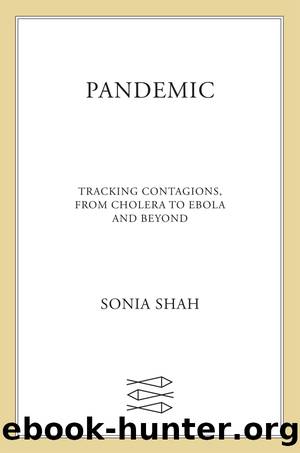Pandemic by Sonia Shah

Author:Sonia Shah
Language: eng
Format: azw3, epub
ISBN: 9780374708740
Publisher: Farrar, Straus and Giroux
Published: 2020-04-22T16:58:45.267434+00:00
SEVEN
THE CURE
Finding out how cholera spread and how to stop it was a matter of great urgency for every part of nineteenth-century society affected by the disease, but no sector more so than the medical community. The arrival of the deadly new disease charged the medical world like a bolt of lightning. By all accounts doctors and scientists worked intensely to unravel cholera’s mysteries and save their stricken patients. They expounded on their ideas about the pathology and transmission of the disease in scores of papers, lectures, conferences, and essays. They developed a bevy of experimental treatments, theories as to how cholera spread, and interventions designed to arrest it.
And yet for decades, effective cures for cholera eluded them.
Their failure was not due to lack of technical capacity. The cure for cholera is almost comically simple. The vibrio does not destroy tissue, like, say, blood-cell-devouring malaria parasites or the lung-destroying tubercle bacilli that cause tuberculosis. It doesn’t hijack our cells and turn them against us, like HIV. As deadly as cholera is, its tenure in the body is really more like a visit from an unpleasantly demanding guest than a murderous assailant. What kills is the dehydration the vibrio causes while replicating in the gut. That means that surviving cholera requires solely that we replenish the fluids it sucks dry. The cure for cholera is clean water, plus a smattering of simple electrolytes like salts. This elementary treatment reduces cholera mortality from 50 percent to less than 1 percent. Preventing cholera by separating human waste from drinking-water supplies was similarly well within the reach of nineteenth-century technology. The aqueducts and reservoirs of the ancients could have done it.1
The failure was not due to a lack of observations about the nature of cholera, either. Scientists and doctors had noted the association between cholera and dirty water since the earliest days of cholera’s emergence in Europe. In Moscow, the epidemic ravaged the banks of the Moskva; in Warsaw, along the banks of the Vistula; in London, along the banks of the Thames. The French surgeon Jacques Mathieu Delpech noted in 1832 that the cholera in England spread from a central point to the periphery, and “that central point was the bank of the river.” That same year, another French commentator observed that cholera spread from a fountain “full of putrid matter,” and once abandoned, “there were no further cases of cholera.”2 In 1833, a medical professor had even published a map of the city of Lexington, Kentucky, which correlated the location of cholera deaths to the local topography and its filth. The same is true for the saltwater cure. It had been first proposed—and supported with solid evidence—in the 1830s.3
Nineteenth-century physicians had made the right observations and had the right technology to cure cholera. The problem was that the right observations and the right technology were beside the point.
* * *
In 1962, the physicist and philosopher of science Thomas Kuhn explained how the practice of science can paradoxically repress as much as it reveals.
Download
This site does not store any files on its server. We only index and link to content provided by other sites. Please contact the content providers to delete copyright contents if any and email us, we'll remove relevant links or contents immediately.
When Breath Becomes Air by Paul Kalanithi(7255)
Why We Sleep: Unlocking the Power of Sleep and Dreams by Matthew Walker(5637)
Paper Towns by Green John(4164)
The Immortal Life of Henrietta Lacks by Rebecca Skloot(3820)
The Sports Rules Book by Human Kinetics(3581)
Dynamic Alignment Through Imagery by Eric Franklin(3482)
ACSM's Complete Guide to Fitness & Health by ACSM(3459)
Kaplan MCAT Organic Chemistry Review: Created for MCAT 2015 (Kaplan Test Prep) by Kaplan(3418)
Introduction to Kinesiology by Shirl J. Hoffman(3297)
Livewired by David Eagleman(3116)
The River of Consciousness by Oliver Sacks(2989)
Alchemy and Alchemists by C. J. S. Thompson(2908)
The Death of the Heart by Elizabeth Bowen(2896)
Descartes' Error by Antonio Damasio(2728)
Bad Pharma by Ben Goldacre(2722)
The Gene: An Intimate History by Siddhartha Mukherjee(2488)
Kaplan MCAT Behavioral Sciences Review: Created for MCAT 2015 (Kaplan Test Prep) by Kaplan(2484)
The Fate of Rome: Climate, Disease, and the End of an Empire (The Princeton History of the Ancient World) by Kyle Harper(2430)
The Emperor of All Maladies: A Biography of Cancer by Siddhartha Mukherjee(2427)
